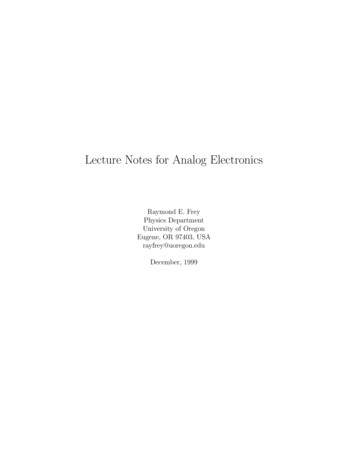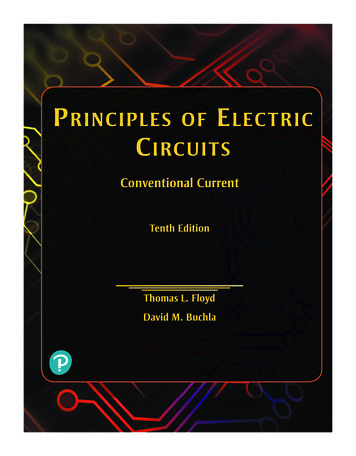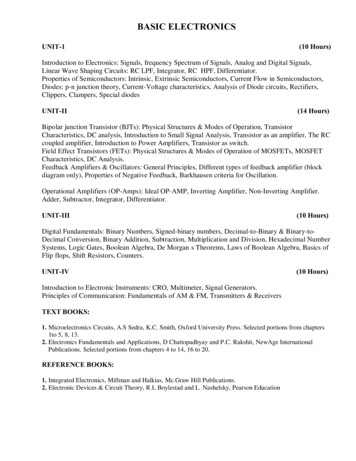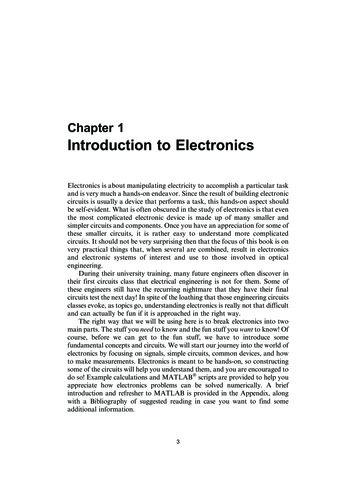
Transcription
PRINCIPLES OFELECTRONICS
INTRODUCTIONSAFETYCHAPTER 1- MEASURING INSTRUMENTS AND TESTING METHODSMetersThe Cathode Ray OscilloscopeSimple Component TestingCHAPTER 2- ECG SEMICONDUCTORS – REPLACEMENT PROCEDURES2.1 Universal Replacements2.2 Replacement Techniques2.2.1 Forming Pins2.2.2 Mounting2.2.3 Soldering2.3 Mosfet Handling Precautions2.4 CMOS Handling Precautions2.5 Selecting a Bi-Polar Transistor for an unlisted type2.6 SCR,Triac,Rectifier and Bridge Replacement2.7 Personalized Service for unlisted Type2.8 Testing Solid – State Devices2.9 Testing Bi-Polar Transistor2.10 Testing Field Effect Transistor2.11 Testing Diodes2.12 Testing SCRs and Triacs (Thyristors)2.13 Symbol, Terms and DefinitionsCHAPTER 3 – SEMICONDUCTORS3.1Semiconductors Materials3.2 Atomic Structure3.3 Diode Characteristics3.4 Diode Applications3.5 Zener Diodes3.6 Light Emitting Diode3.7 Point Contact Diode3.8 Transistors3.9 Transistors Circuit Configurations3.10 Transistors DataCHAPTER 4 – POWER SUPPLY CIRCUITS4.1 Basic Principles of DC Power Supplies4.2 The Linear Stabilized Power Unit4.3 Switching Mode Power Supplies4.4 Power Supply Protection Circuits4.5 Testing Power Supply Circuits4.6 Fault Finding Techniques and Typical Fault ConditionsCHAPTER 5 – SINGLE STAGE TRANSISTOR AMPLIFIER5.1 Basic Principles5.2 Resistor Faults
5.3 Capacitor Faults5.4 Transistor FaultsCHAPTER 6 – THE FIELD EFFECT TRANSISTOR6.1 Operation of the JFET6.2 Operation of the MOSFET6.3 Operation of the VMOSFET6.4 Operation of the IGFET6.5 Common Drain AmplifierCHAPTER 7 – OPERATIONAL AMPLIFIER SYSTEMS7.1 Sign Changer7.2 Scale Changer7.3 Phase Shifter7.4 Summing Amplifier7.5 Noninverting Summoning7.6 Transconductance AmplifierCHAPTER 8 – AMPLIFIER CIRCUITS8.1 Types and Classes of Amplifiers8.2 Negative Feedback8.3 Testing Amplifiers: Basic Measurements8.3.1 Measurements of Gain8.3.2 Measurement of Frequency Response and Bandwidth8.3.3 Measurement of Input Impedance8.3.4 Measurement of Output Resistance8.3.5 Measurement of Power Output, Efficiency and Sensitivity for anAudio Amplifier8.4 Transient Testing of Amplifiers8.5 Distortion Measurements8.5.1 Amplitude Distortion8.5.2 Frequency Distortion8.5.3 Phase Distortion8.5.4 Cross-Over Distortion8.5.5 Intermodulation Distortion8.6 Faults in AmplifiersCHAPTER 9 – OSCILLATOR AND TIME BASE CIRCUITS9.1 Principles of Oscillators9.2 Measurement of Frequency9.3 Frequency Stability9.4 Harmonic Distortion9.5 Square and Pulse Waveforms9.6 Sawtooth and Ramp Circuits9.7 Negative Resistance Oscillators9.8 Fault Finding on OscillatorsCHAPTER 10 – PULSE AND WAVEFORM SHAPING CIRCUITS10.1 Introduction10.2 Linear Passive Circuits – the Integration and Differentiation
10.3 Diode Waveform Shaper10.4 Active Pulse Shaping Circuits10.5 The Schmitt Trigger Circuit10.6 The Monostable10.7 Fault Finding in Pulse and Waveform Shaping CircuitsCHAPTER 11 – CIRCUITS USING ANALOGUE AND DIGITAL INTEGRATED CIRCUITS11.1 Introduction to Integrated Circuits11.2 Analogue ICs11.3 Digital ICs11.4 Servicing Instruments Continuing ICs
ForewordThis text was produced specifically for use in the short course “Principles of Electronics”. It provides specificand general information for persons wishing to obtain an introductory practical knowledge of electronics. Thestep-by-step design takes the reader through the use of electronic tools, the workings of electronic devices, standard electronic circuits and the practical use of electronics.This is not a text manual but a course guide and handbook. The information in this manual should be followedby additional reading and practice by the participant after, or even during, the programme.This manual was compiled from information contained in several published sources and experiments developedby the author.The following sources were used:ECG ManualElectronic Fault DagnosisPractical ElectronicsElectrical Engineers Hand BookLucas Nulle Training GuideTele-A-TrainShould further reading be required MIC/NSDP will be pleased to supply names of books and publishers wheresuch specifics are available.MIC/NSDP makes no claims to the material contained herein.THIS BOOK IS NOT FOR SALECompiled by:Tagore RamlalMarch 1997Introduction by Garth Joseph
INTRODUCTIONElectronics has been defined as “that field of science and engineering which deals with electron devices andtheir utilization”. Electronic devices are “devices in which electrical conduction is principally electrons movingthrough a vacuum, gas or semi-conductor”.Generally Electronics can be defined as “the science and technology of the passage of charged particles in a gas,in a vacuum, or in a semi-conductor”. Electrons and mobile holes are the most important of charge carriers inelectronic devices but ions also play part.Brief HistoryBefore electronic engineering came into existence, electrical engineering already flourished. Electrical engineering deals with devices that depend solely on the motions of electrons in metals, for example, generators, motors,light bulbs and telephones. The principal benefactors of these devices are the wire telephone or telegraph companies and the power industries.The introduction of the semiconductor transistor in the late 1940’s caused dramatic change in the electronicsindustry. Apparent unlimited miniaturization has resulted. Advantages of semiconductors include smaller andlightweight equipment, no heater requirement or heater loss (as required for tubes), more rugged construction,etc. Tubes are still used in a few isolated areas.Progress is seen in radio, television, computer, automobile and space age development. Most manufacturedproducts used today have been made better or more economical through the use of electronics. Automation usually means electronic control of machine operation. In 1958 at Texas Instruments the monolithic was conceivedwhereby an entire circuit out of germanium or silicon would be built. The bulk semiconductor was used to forma resistor. A capacitor was built by using an oxide layer (for the dielectric) on silicon. These concepts led to thesolid circuit or integrated circuit being announced in 1959 at the IRE convention.Types of DevicesMiniature semiconductor systems are encased in containers simply to provide a means of handling, protectingand connecting the. Reliability, speed and production yields have improved, while cost, power consumption,and size have been reduced drastically.Microelectronics describe high-density Integrated Circuits (ICs) or chips, and refers to the technologies involved in their design, fabrication and use. The prefix “micro” alludes to the tremendous size reductions thathave been taken.Micro-electronic devices are used in printed circuits as dual-in-line packaged (DIP) monolithic ICs or as thick –or thin-film hybrids. Functional devices include Gunn diodes, IMPATT diodes, charge injection devices (CID’s),charge-coupled devices (CCD’s), bipolar function transistors and MOSFET integrated circuits.The most remarkable aspect of the modern technology is the ability to pack a tremendous number of functionsinto a physically small area. A nonmenclature has developed in the digital area to describe the degree of packingdensity. Small-scale integration (SSI), medium-scale integration (MSI) and large-scale integration (LSI). Verylarge-scale integration (VLSI) refers to digital chips with 10,000 or more devices.LSI chips with several thousand devices or memory elements, plus associated input and output circulatoryfor such items as digital watches, pocket calculators and microprocessors are common. The impact of LSI oncalculators and computers is obvious. These devices have caused great changes in the industrial process control,automotive electronics and other fields where data acquisition, computation or controls are necessary. An exten-
sive vocabulary associated with microelectronics has developed.SummaryAs electronics moves rapidly towards very extensive use of integrated-circuits arrays, the fundamental operations with linear and non-linear active elements become increasingly important. Hence, primary emphasiscontinues to be placed on feedback, gain elements, modulation, frequency conversation, oscillation, and logic.Electronic equipment is made up of three basic circuits, rectifiers, amplifiers and oscillators. There are also afew additional types of special circuits which are basically variations of the basic circuits. Finally there are onlysix commonly used types of electronic circuits, these are resistors, capacitors, inductors, transformers switchesand valves (vacuum tubes diodes transistors).
SAFETYA technician will install, maintain, and repair electrical and electronic equipment in which dangerously highvoltages are present. This work is often done in confined spaces. Among the hazards of this work are electricalshock, electrical fires, harmful gases which are sometimes generated by faulty electrical and electronic devices,injuries which may be caused by improper use of tools.Because of these dangers, one should formulate safe and intelligent work habits since these are fully as important as knowledge of electronic equipment. One primary objective should be to learn to recognize and correctdangerous conditions.Electric ShockElectric shock may cause burns of varying degree, cessation of breathing and unconsciousness, ventricularfibrillation or cardiac arrest and death. If a 60-hertz alternating current is passed through a person from hand tohand or from hand to foot, the effects when current is gradually increased from zero are as follows:1. At about 1 milli-ampere (0.001 ampere) the shock will be felt.2. At about 10 milli-amperes (0.01 ampere) the shock is enough to paralyze muscles and a persons maybe unable to release the conductor.3. At about 100 milli-amperes (0.1 ampere) the shock is usually fatal if it lasts for one second or more.IT IS IMPORTANT TO REMEMBER THAT FUNDAMENTALLY, CURRENT, RATHER THANVOLTAGE, IS THE CRITERION OF SHOCK INTENSITY.It should be clearly understood that resistance of the body will vary. That is, if the skin is dry and unbroken,body resistance will be quite high, on the order of 300,000 to 500,000 ohms. However, if the skin moist orbroken, body resistance may drop to as low as 300 ohms. Thus, a potential as low as 30 volts could cause a fatalcurrent flow. Therefore, any circuit with a potential in excess of this value must be considered dangerous.Care of shock victimsElectric shock is a jarring, shaking sensation resulting from contact with electric circuits or from the effects oflightning. The victim usually experiences the sensation of a sudden blow, and if the voltage is sufficiently high,unconsciousness, severe burns may appear on the skin at the place of contact; muscular spasm can occur, causing a person to clasp the apparatus or wire which caused the shock can kill its victim by stopping the heart or bystopping breathing or both. It may sometimes damage nerve tissue and result in a slow wasting away of musclesthat may be become apparent until several weeks or months after the shock is received.The following procedure is recommended for the rescue and care of shock victims.1) Remove the victims from electrical contact at once, but DO NOT ENDANGER YOURSELF.This can be done by : (1) throwing the switch, if it is nearby; (2) using a dry stick, rope, leather belt,coat, blanket or any other non-conductor of electricity; or (3) cutting the cables or wires to the apparatus, usinga damage control axe while taking care to protect your eyes from the flash when the wires are severed. Even thevictim’s shoes, if dry, can be used to pull hi clear.2) Determine whether the victim is breathing. If so, keep him lying down in a comfortable position.Loosen the clothing about his neck, chest and abdomen so that he can breathe freely. Protect him from exposureto cold, and watch him carefully.3) Keep him from moving about. After shock, the heart is very weak, and any sudden muscular effort oractivity on the part of the patient may result in heart failure.4) Do not give stimulants or operates. Send for a medical officer at once and do not leave the patientutilize has adequate medical care.
5) If the victim is not breathing, it will be necessary to apply artificial respiration without delay, eventhough he may appear to be lifeless.Working on Energized CircuitsInsofar as is practical, a technician should NOT undertake repair work on energized circuits and equipment.However, if it should become necessary, as when making operational adjustments, then one should carefullyobserve the following safety precautions:1) Ensure that you have adequate illumination. You must be able to see clearly, if you are to safely andproperly perform the job.2) Ensure that you are insulated from ground by an approved type rubber mat, or layers of dry canvasand/or wood.3) Where practical, use only one hand, keeping the other either behind you or in your pocket.4) If the system voltage exceeds 150 volts, rubber gloves should be worn.5) An assistant should be stationed near the main switch or circuit breaker, so that the equipment may beimmediately de-energized in case of an emergency.6) A man qualified in first aid for electrical shock should be standing by during the entire operation.7) DO NOT WORK ALONE.8) Do not work on any type of electrical apparatus when wearing wet clothing, to if he hands are wet.9) DO NOT wear loose or flapping clothes.10) The use of thin-soled shoes and shoes with metal plates or hob nails should not be worn.11) Flammable articles, such as cellulose cap visors should not be worn.12)All rings, wristwatches, bracelets, and similar metal items should be removed before working onequipment. Also ensure that clothing does not contain exposed metal fasteners such as zippers, snaps, buttonsand pins.13) Do not tamper with interlock switches, that is, do not defeat their purpose by shorting them or blocking them open.14) Ensure that equipment is properly grounded before energizing.15) De-energize equipment before attaching alligator clips to any circuit.16) Use only approved meters and other indicating devices to check for the presence of voltage.17) Observe the following procedures when measuring voltages in excess of 300 volts. Turn off the equipment power. Short circuit or ground the terminal of all components capable of retaining a charge. Connect the meter leads to the points to be measured. Remove any terminal grounds previously connected. Turn on the power and observe the voltage reading. Turn off the power. Short circuit or ground all components capable of retaining a charge. Disconnect the meter leads.18) On all circuits where the voltage is in excess of 30 volts and where the deck, bulkheads, or workbenches are of metallic constructions, the workers should be insulated from accidental ground by use of approved insulating material.The insulating material should have the following qualities: It should be dry, without holes, and should not contain conducting materials. The voltage rating for which it is made should be clearly marked on the material, and the propermaterial should be used so that adequate protection from the voltage can be supplied. Dry wood may be used, or as an alternative, several layers of dry canvas, sheets of phenolicinsulating material, or suitable rubber mats. Care should be exercised to ensure that moisture, dust, metal chips, etc. which may collect on
insulating material is removed at once. Small deposits of such materials can become electrical hazards. All insulating materials on machinery and in the area should be kept of oil, grease, carbon dust,etc., since such deposits destroy insulation.Safety shorting probeALWAYS ASSUME THAT THERE IS VOLTAGE PRESENT when working with circuits having high capacitance even when the circuit has been disconnected from its power source. Therefore, capacitors in such circuitsshould be discharged individually, using an approved type shorting probe. High capacity capacitors may retaintheir charge for a considerable period of time after having been disconnected from the power source.When using the safety shorting probe, always be sure to first connect the test clip to a good ground (if necessary,scrape the paint of the grounding metal to make a good contact). Then hold the safety shorting probe by theinsulating handle and touch the problem end of the shorting rod to the point to the shorted out. The problem endis fashioned so that it can be hooked over the part or terminal to provide a constant connection by the weightof the handle alone. Always take care not to touch any of the metal parts of the safety shorting problem whiletouching the probe to the exposed “hot” terminal. It pays to be safe; use the safety shorting probe with care.Some equipment are provided with walk-around shorting such as fixed grounding studs (or permanently attached grounding rods). When this is the case, these should be used rather than the safety shorting probe.Working on De-energized CircuitsWhen any electronic equipment is to be repaired or overhauled, certain general safety precautions should beobserved.They are as follows;Remember that electrical and electronic circuits often have more than one source of power. Take timeto study the schematics or wiring diagrams of the entire system to ensure that all sources of power have beendisconnected.If pertinent, inform the remote station regarding the circuit on which work will be performed.Use on hand when turning switches on or off.Safety devices such as interlocks, overload relays, and fuses should never be altered or disconnected except for replacement. In addition, they should never be changed or modified in any way without specific authorization.Fuses should be removed and replaced only after the circuit has been de-energized. When a fuse blows,the replacement should be of the same type and have the same current and voltage ratings. A fuse puller shouldbe used to remove and replace cartridge type fuses.All circuit breakers and switches from which power could possibly be supplied should be secured(locked if possible) in the open or off (safety) position and tagged.After the work has been completed, the tag (or tags) should be removed ONLY by the same person whosigned it when the work began.Keep clothing, hands, and feet dry if possible.When it is necessary to work in a wet or damp locations, use a dry platform or wooden stool to sit or stand on,and place a rubber mats or other non-conductive material on top of the wood. Use insulated tools and insulatedflashlights of the moulded type when required to work on exposed parts.
CHAPTER 1MEASURING INSTRUMENTS AND TESTING METHODS1.1 Meters1.2 The Cathode Ray Oscilloscope1.3 Simple Component Testing
CHAPTER 1[1.1] Measuring Instruments and Testing Methods(1)MetersTo get information about the symptoms of a particular fault, a set of voltage readings at critical points in thecircuit must be taken. This information, together with additional information on the circuit performance (i.e.distorted output, overheating component) is usually all that is necessary for correct fault diagnosis. So the onlyessential piece of test equipment for fault finding is a good, general purpose multi-range meter. This should havea resistance on d.c. ranges of at least 20 kΩ per volt. It is important that the meter has a relatively high resistance, otherwise the loading effect of the voltmeter could lead to incorrect conclusions. Also when measuringvoltages in circuits that have fairly high resistances, the loading effect must be considered.Take for example the potential divider shown in Fig.1. The voltage across R2 should be 13.3V. If a meter of20 kΩ on the 10V d.c. range is connected across R2 it will actually indicate nearly 10V. If a higher range ofthe meter is selected, the meter current is reduced, and a more accurate indication is given. It is always wise toselect the highest possible range when measuring voltages in high resistance circuits.An alternative to the moving coil meter is the small, portable digital multimeter. This displays the measuredvoltage, current or resistance on a three or more in-line digital display. The more digits used, the greater theaccuracy of the reading. The input resistance of these instruments is typically 10 MΩ, which means that the unittakes only a small current from the circuit being measured. It seems that the instrument will replace the movingcoil type meter because of the accuracy, readability and high input resistance. However, unless otherwise stated,in all the exercises in the following chapters the measurements have been made using a standard moving coiltype meter, mainly because of the ready availability of this instrument.
[1.2] The Cathode Ray OscilloscopeAmong other useful instruments the next important from the point of view of fault finding is the cathode rayoscilloscope (CRO). This is perhaps the most versatile measuring instrument available. With it, it is possibleto measure d.c. and a.c., voltage, current, phase-angle, and a whole range of other quantities. The accuracydepends to a great extent upon the care paid to the instruments’ calibration, and in most modern oscilloscopessignals for calibration are built in. The typical input impedance of a CRO is 1 MΩ which has a capacitance ofabout 20 pF in parallel with it. The input impedance can always be increased by using a special probe unit. Aprobe is simply a test lead which contains either a passive or an active network at its end or at some point alongthe lead. The straightforward voltage-divider probe is a basic attenuator with good frequency compensation.The latter is usually adjustable and should be checked before use. A disadvantage of this arrangement is that thesignal attenuation is high typically 10:1 or 100:1; this is why the probes are called x10 or x100.The “heart” of an oscilloscope is the cathode ray tube (CRT). This consists of an electron gun, a deflectionsystem and a fluorescent screen. A high velocity, finely focused electron beam is produced by the electron gun.This beam passes between two sets of plates arranged at right angles. Voltages applied to these plates deflect thebeam both horizontally and vertically. The beam finally strikes the screen and a fine point of light is produced.This spot of light can be moved to any part of the screen by applying signals to the horizontal and vertical deflection plates. These signals are produced from the Y-amplifier and the timebase.A signal to be measured is applied to the Y-input of the CRO, is attenuated by the switched attenuator (theY-amplitude control), then amplified by the Y-amplifier and applied to the vertical plates of the CRT. At thesame time the timebase units is triggered to produce a sawtooth signal that, when applied to the horizontalplates, causes the spot to move across the screen at a uniform rate and then fly back and repeat the process. Theresult is that a bright trace of the input signal appears on the screen.This trace can only be held stationary if the trigger control on the CRO timebase is correctly set. For a singlebeam CRO there are two possible triggering modes: external or internal. The external position should be selected only when a trigger signal is available; this feature can be extremely useful when measuring the time orphase relationship between two signals, as will be seen later. The normal mode for the trigger is to select internal. To hold the trace, switch the trigger select switch to INT and then adjust TRIG. LEVEL (or TRIG. STABILITY) until the trace locks.Suppose we wish to measure the frequency and amplitude of an unknown sine wave signal. The CRO is set upwith no input so that first of all the trace is located (some instruments incorporate a beam finder for this purpose). The BRILL and FOCUS controls should be set to give a clear fine line on the screen. The signal to bemeasured is applied to the Y-input as shown in Fig.2 and the Y-amplitude control and the TIME switch set untilthe signal can be easily measured. In the example the Y-amplitude control is at 2V/cm and the time switch isat 0.1 ms/cm. Therefore the unknown signal has an amplitude of 5V peak and a periodic time of 0.20ms. Thefrequency is then given byAs stated previously the CRO is a highly versatile instrument but always make sure that it is calibrated correctlyand set to a calibrated position.Many modern CROs have double beams which can be used to display two time-related signals. An example isgiven in Fig.3 where the signals from an astable oscillator are shown. Only one channel can be used to triggerthe Timebase so an additional switch is included that allows one to select either Y1 or Y2 for internal trigger.A single beam CRO can also be used for measurements of phase between signals by applying one signal to theexternal trigger of the timebase while the other is fed to the Y-input.t
[1.3] Simple Component TestingWhen an instrument is being serviced and the checks indicate that a certain component is suspect, it is thennecessary to confirm the fault. Often simply replacing the component is a sufficient check, but it is always goodpractice to test the faulty component to verify the type of fault. This useful for a number of reasons, the mostimportant being the collection of data on component failures. A fault may be caused by defects in componentmanufacture, a design error, poor production methods, or ageing. Thus, for example, if a large number of components are failing open circuit, the manufacturer will need to be informed so that future defects can be avoided.Tests to confirm open or short circuit conditions can easily be made using the ohms range of a multi-range meter, but while checking for an open circuit it is usually wise to unsolder and lift one end of the component beforemaking the measurements, otherwise other components that are in parallel with the suspect component will givea false indication of the resistance. An alternative method of checking for an open circuit resistor is to “bridge”the suspect component with a known good one, and then recheck the circuit conditions.“Leaky” capacitors can also be tested using an ohmmeter, again by disconnecting one end of the capacitor fromthe circuit. A good electrolytic should indicate a low resistance initially as the capacitor charges, but the resistance should rapidly increase to approach infinity. Open circuit capacitors are best confirmed by placing anothercapacitor of the same value in parallel and checking circuit operation, or by removing the capacitor and testingit on a simple laboratory set-up as shown in Fig.4 A using a low frequency generator at 1 kHz and two meters.HereCx I/2πfV0 with an accuracy of better than 10% for values from 1000pF to 1µF. An even better method is touse a simple a.c. bridge as shown in Fig.4 B to compare the unknown capacitor against a standard.Tests on diodes, transistors and other semiconductor devices can also be made using the ohms range of a multimeter.First it is necessary to determine how the internal battery in your multimeter is connected. For example, in onetypical instrument the common terminal (marked black) has a positive voltage on the resistance range. If you donot know the connections for the particular meter you are using, the polarity can be determined by connectingthe multimeter (on ohms range) to an electronic voltmeter, or by measuring the forward and reverse resistanceof a semiconductor diode of known polarity. See Fig.5.Having established the ohmmeter lead polarity, you can discover a great deal about a transistor. First identifythe device leads if not known (see Fig.6). Measure the forward and the reverse resistance between pairs of leadsuntil you find two that measure high (over 100 kΩ) in both directions. These must be the collector and emitter(provided the transistor is a good one). The remaining lead is the base. Now measure the resistance from base toone of the other transistor leads; it should be low in one direction (1 kΩ) and high (greater than 100 kΩ) in theother. If the low resistance occurs when the ohmmeter lead with the positive voltage is connected to the transistor base, the transistor will be n-p-n type. Of course, it will be the other way around for p-n-p.The above check also tests that both emitter base and collector base junctions in the transistor are good. If eitherjunction shows up high resistance in both directions, it is open circuit; and low resistance in both directions, it isbroken down.When testing components, and in particular transistors, FETs and ICs ALWAYS:1) Check for power supplies near the actual components, and in the case of ICs directly on the appropriate pins.2) Do not use large test probes because they can easily cause shorts.3) Avoid the use of excessive heat when unsoldering a component and do not unsolder with the unitswitched on.4) Never remove or plug in a device without first switching off the power supply. Components can bedamaged easily by the excessive current surges.
The complete circuit of most electronic instruments can be broken down into a series of functional blocks; forexample in a general purpose sine wave generator these would be power supply, variable sine wave oscillator,buffer amplifier, and output attenuator. By treating the instrument in blocks, rather than as a whole, it is possible to narrow down the search for a faulty component first of all to one block, then by measurements withinthe block to locate the actual faulty component. The methods used to decide which block is faulty are:a) Input to output (or beginning to end).b) Output to input.c) Random.d) Half-split.All of these have their particular advantages and uses. The RANDOM METHOD, which implies a totallynon-systematic approach, is rarely used. A method based on the reliability of components can also be usedwhen there is a wealth of service knowledge and experience concerning a particular instrument. For example a serv
Practical Electronics Electrical Engineers Hand Book Lucas Nulle Training Guide Tele-A-Train Should further reading be required MIC/NSDP will be pleased to supply names of books and publishers where such specifics are available. MIC/NSDP makes no claims to the material contained herein. THIS


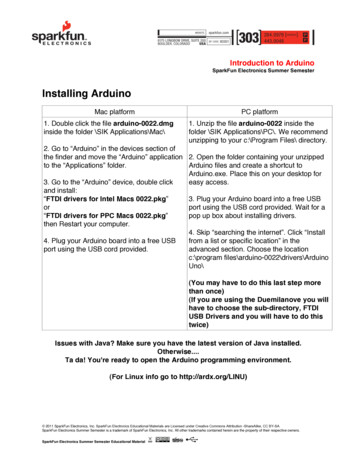



![History of Electronics electricity [Read-Only]](/img/18/history-20of-20electronics-20-20electricity.jpg)
